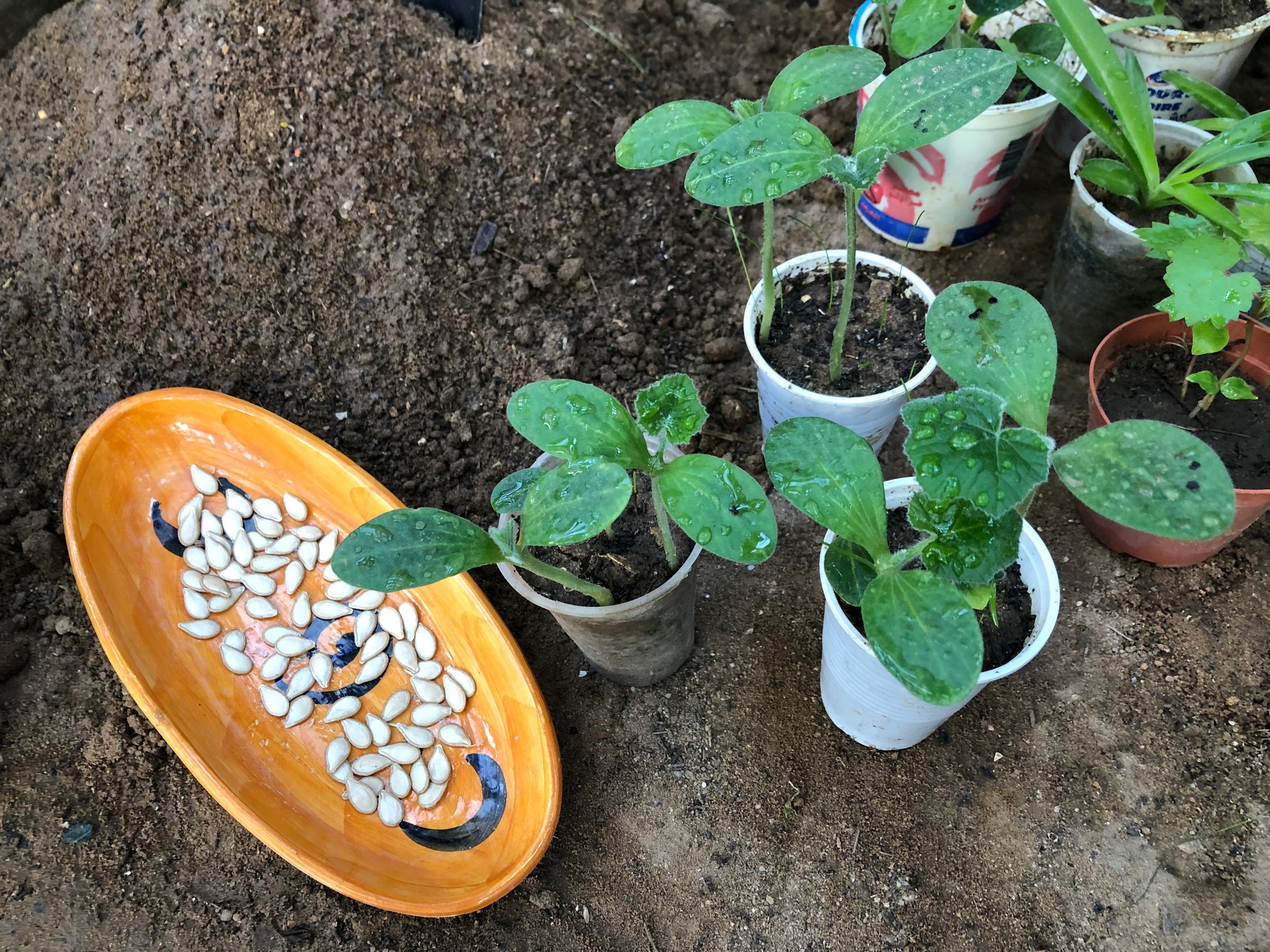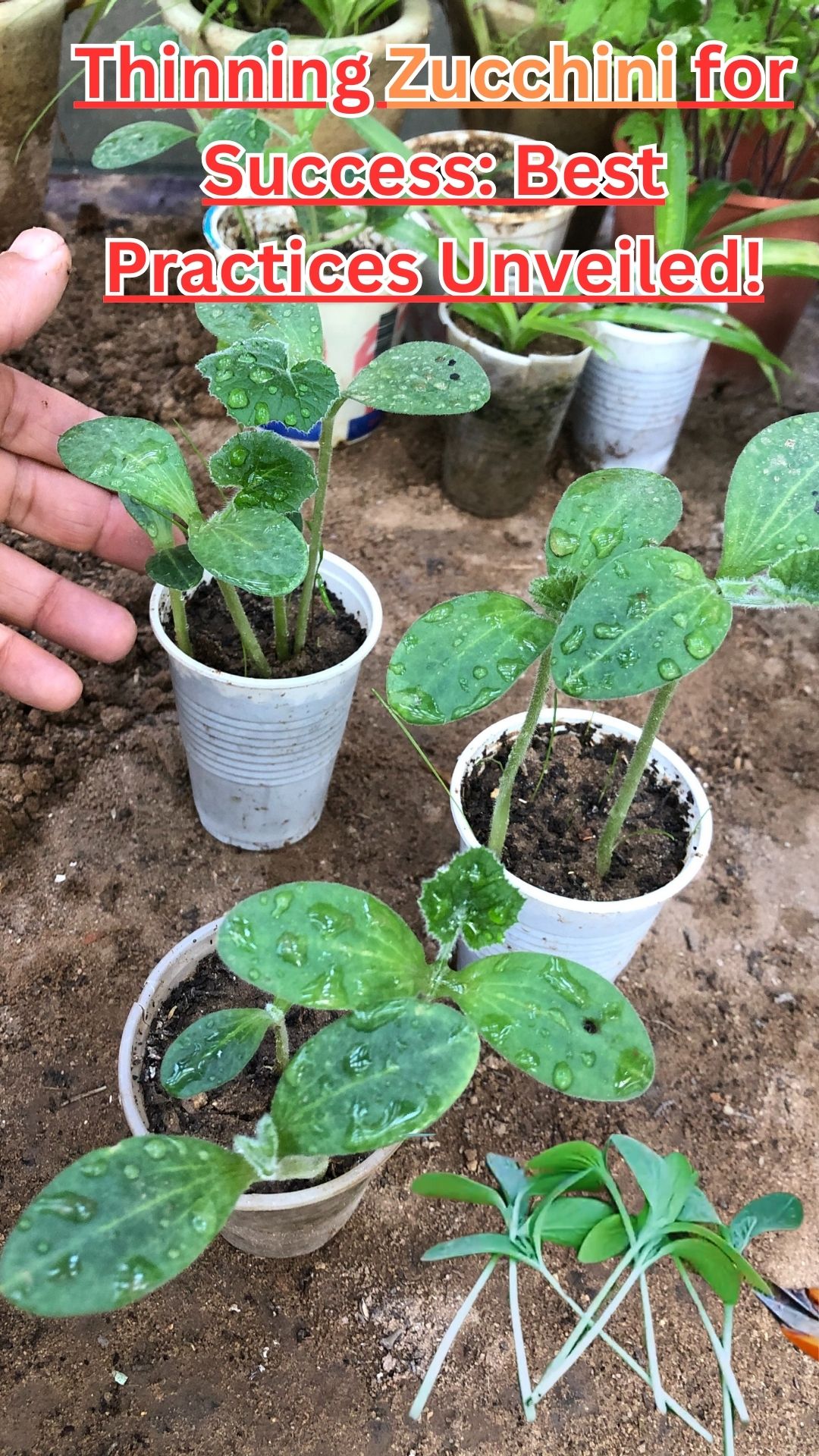Thinning zucchini seedlings is essential to ensure optimal growth and productivity by preventing competition for resources like nutrients, water, and sunlight. Removing excess seedlings allows for adequate space for the remaining plants to thrive, resulting in healthy and productive zucchini plants. This guide will detail a step-by-step process for thinning zucchini seedlings to effectively manage growth and maximize potential.
What are Zucchini Seedlings?
Zucchini seedlings are the early, tender growth stage of zucchini plants that emerge from seeds. These delicate seedlings require proper care and attention to ensure their successful transition into mature, productive zucchini plants.
Growth Process of Zucchini Seedlings
Zucchini seedlings typically begin as small, delicate sprouts emerging from the soil after the seeds have germinated. As they grow, they develop their first set of seed leaves, followed by the emergence of true leaves. The true leaves are an indication that the seedlings are maturing into established plants.
Importance of Thinning for Healthy Zucchini Plants
Thinning zucchini seedlings is vital for several reasons:
Resource Allocation: By thinning the seedlings, the remaining plants receive a more significant share of essential resources such as nutrients, water, and sunlight, promoting healthier growth.
Air Circulation and Disease Prevention: Adequate spacing resulting from thinning allows for better air circulation, reducing the risk of diseases that thrive in crowded, humid conditions.
Avoiding Competition: Overcrowded seedlings compete for resources, leading to stunted growth and diminished yields. Thinning helps alleviate this competition, promoting stronger, more productive plants.
Knowing how zucchini seedlings grow and the importance of thinning is essential for cultivating strong and thriving zucchini plants capable of producing a plentiful harvest.
Signs that Indicate it's Time to Thin Out Zucchini Seedlings
Several signs indicate that it's time to thin out zucchini seedlings:
Crowded Growth: When the seedlings start to appear overcrowded, with their leaves and stems competing for space, it's a clear indication that thinning is necessary.
Development of True Leaves: As zucchini seedlings develop their first set of true leaves, typically the second set of leaves after the initial seed leaves, it's an opportune time to assess and thin out the weaker seedlings.
Recommended Time Frame for Thinning for Best Results
The recommended time frame for thinning zucchini seedlings is when they are approximately 2-3 weeks old and have developed their first set of true leaves. This stage allows for easier identification of the stronger seedlings and ensures that the remaining plants have ample time to establish themselves before reaching maturity.
Gather Necessary Tools
Before thinning zucchini seedlings, ensure you have the following tools:
Small garden scissors or pruning shears: These are useful for precisely snipping off excess seedlings without disturbing the surrounding soil or roots.
Watering can or a gentle spray nozzle: To moisten the soil before thinning and to water the remaining seedlings after the process.
Organic mulch: Optional but beneficial for retaining moisture and suppressing weed growth after thinning.
Having these tools readily available will streamline the thinning process and help maintain the health of the remaining seedlings!
Identify seedlings to remove when thinning zucchini seedlings, consider the following factors to identify which seedlings to remove:
Size: Select the smaller, weaker-looking seedlings for removal. These are often easily identifiable by their smaller overall size and less robust appearance compared to their healthier counterparts.
Health: Look for seedlings with yellowing or distorted leaves, stunted growth, or other signs of poor health. These are prime candidates for removal as they are less likely to thrive compared to healthier seedlings.
By prioritizing the removal of smaller and less healthy seedlings, you can ensure that the stronger and more vigorous plants have the best chance of thriving and producing a bountiful harvest.
Carefully Remove Excess Seedlings:
Follow these detailed instructions to remove excess seedlings without damaging the remaining plants:
Prepare the Soil: Water the soil around the seedlings lightly to moisten it. This makes it easier to remove the unwanted seedlings without disturbing the roots of the remaining plants.
Identify and Select Seedlings: Identify the weaker or excess seedlings based on size and health. Use the small garden scissors or pruning shears to carefully snip the unwanted seedlings at soil level. Avoid pulling them out, as this can disturb the roots of the remaining seedlings.
Dispose of Removed Seedlings: Collect the removed seedlings and dispose of them appropriately, ensuring they are not left near the zucchini plants to prevent potential disease or pest issues.
Water the Remaining Seedlings: After thinning, make sure to water the remaining seedlings softly to help the soil settle around their roots and give them the necessary moisture for recuperation after thinning.
Following these steps will help you carefully remove excess zucchini seedlings without causing harm to the remaining plants, promoting healthy growth and development.
Aftercare
After thinning your zucchini seedlings, it's important to provide proper care to promote healthy growth. Here are some tips for aftercare:
Watering: Ensure the remaining seedlings are adequately watered. Keep the soil consistently moist, but not waterlogged, to support healthy root development and overall growth.
Fertilization: Consider applying a balanced, water-soluble fertilizer to the soil around the remaining seedlings. This provides essential nutrients to support their growth and development.
Mulching: Apply a layer of organic mulch, such as straw or shredded leaves, around the base of the remaining seedlings. Mulch helps retain soil moisture, suppresses weed growth, and regulates soil temperature.
Sunlight: Ensure the thinned seedlings receive ample sunlight. Position them in a location that receives at least 6-8 hours of direct sunlight per day to support strong and healthy growth.
Monitoring: Keep an eye on the remaining seedlings for any signs of pests, diseases, or nutrient deficiencies. Promptly address any issues that may arise to ensure the plants continue to thrive.
By providing proper aftercare, you can support the healthy growth of the thinned zucchini seedlings, setting the stage for a successful and productive harvest.
Common Mistakes to Avoid
When thinning zucchini seedlings, it's important to be mindful of common mistakes and take steps to prevent damage to healthy plants. Here are some key points to consider:
Common Mistakes to Avoid:Waiting Too Long to Thin: Delaying thinning can lead to overcrowding, competition for resources, and stunted growth of the remaining seedlings.
Rough Handling: Pulling or tugging on seedlings during thinning can disturb the roots of the remaining plants and potentially cause irreversible damage.
Underestimating Spacing Needs: Failing to provide adequate spacing between the remaining seedlings can lead to overcrowding, reduced airflow, and increased susceptibility to diseases.
Overlooking Aftercare: Neglecting to provide proper aftercare, including watering, fertilization, and monitoring, can hinder the healthy development of the thinned seedlings.
Preventing Damage to Healthy Plants:Use Sharp Tools: When thinning, use clean and sharp scissors or pruning shears to carefully snip the unwanted seedlings at soil level. This minimizes the risk of accidental damage to nearby healthy plants.
Handle with Care: Gently grasp the unwanted seedlings at the base of the stem and carefully pull them from the soil, taking care not to disturb the surrounding healthy plants.
Provide Adequate Watering: Ensure the soil is adequately moist before thinning to facilitate the removal of excess seedlings without causing undue stress to the remaining plants.
By being mindful of these common mistakes and taking preventive measures, you can successfully thin zucchini seedlings while minimizing the risk of damage to healthy plants, ultimately promoting robust growth and a bountiful harvest.
Watch: Expert Tips for Thinning Zucchini Seedlings the Right Way 🌱
Conclusion
Thinning your zucchini seedlings is essential for encouraging their healthy growth and increasing your zucchini plants' yield. By carefully following the provided instructions, you can make sure that the remaining seedlings have enough room, nutrients, and care to prosper.
Importance of Thinning Zucchini Seedlings: Thinning zucchini seedlings allows the remaining plants to access essential resources such as sunlight, water, and nutrients without competition. This process reduces overcrowding, enhances airflow, and minimizes the risk of disease, ultimately contributing to stronger, more productive plants.
Encouragement for Readers: I encourage you to apply the detailed step-by-step guide for thinning zucchini seedlings. By carefully removing excess seedlings, spacing the remaining plants appropriately, and providing diligent aftercare, you can set the stage for a successful growing season and a plentiful zucchini harvest.
Remember, the effort invested in proper thinning and aftercare will be rewarded with healthy, vigorous zucchini plants and an abundant yield. Happy gardening!
Here are frequently asked questions with answers about the topic "Thinning Zucchini Seedlings":
What is the significance of thinning zucchini seedlings?
Thinning zucchini seedlings is crucial to lessen overcrowding, enhance airflow, and guarantee that the remaining plants receive sufficient sunlight, water, and nutrients, resulting in healthier and more productive zucchini plants.
When should zucchini seedlings be thinned?
Zucchini seedlings should be thinned when they have grown their first true leaves and are approximately 3-4 inches tall, usually 2-3 weeks after germination.
How far apart should zucchini seedlings be spaced after thinning?
For in-ground planting, space the remaining zucchini seedlings approximately 24 to 36 inches apart to allow for optimal growth. Container-grown zucchinis should be placed in containers that are at least 5 gallons in size.
What are the common mistakes to avoid when thinning zucchini seedlings?
Common mistakes to avoid include waiting too long to thin, rough handling of seedlings, underestimating spacing needs, and overlooking proper aftercare, such as watering and fertilization.
What steps can I take to avoid harming healthy plants when thinning?
To protect healthy plants, utilize sharp tools like scissors or pruning shears, handle seedlings carefully, and make sure the soil is moist before thinning to make it easier to remove extra seedlings.
Can I consume the thinned zucchini seedlings?
Yes, thinned zucchini seedlings are edible and can be included in salads or used as garnishes, providing a method to reduce waste and enhance dishes with a fresh, subtle taste.
What aftercare do thinned zucchini seedlings require?
After thinning, it's important to provide proper aftercare, including regular watering, fertilization, mulching, and monitoring for pests and diseases to ensure the healthy growth of the remaining seedlings.
Is it advisable to transplant zucchini seedlings that have been thinned out?
It is generally not recommended due to potential stress and root disturbance. It is better to focus on healthy growth in their current location.
How soon do zucchini seedlings usually recover from thinning?
Zucchini seedlings typically recover within a week or two with proper aftercare, including watering and nutrients.
What are some signs that indicate zucchini seedlings are not thriving after thinning?
Signs that indicate zucchini seedlings are not thriving after thinning include wilting, yellowing of leaves, stunted growth, and an overall lack of vigor. These signs may indicate issues such as overwatering, nutrient deficiencies, or pest infestations.
Want to grow ZUCCHINI!
🌱Zucchini Squash Seed Collection for Planting - Black Beauty, Grey, Round, Golden, and Cocozelle - Non-GMO
Pin for later!
Enjoyed these tips on thinning zucchini seedlings? Don't forget to hit the like button, share with your fellow gardening enthusiasts, and leave a comment sharing your own experiences with zucchini care! Your engagement helps us grow and supports our gardening community. Happy gardening!
Affiliate Disclosure: In transparency and compliance with legal guidelines, please be aware that some of the links on this site are affiliate links. These are carefully chosen products that I have personally used, tested, and genuinely recommend. When you click and make a purchase through these links, I may earn a small commission, at no additional cost to you. This commission helps support the maintenance of this site, allowing me to continue providing valuable content and recommendations. Rest assured, my priority is to offer authentic and reliable information, and I only affiliate with products that align with the values and standards I uphold. Your trust means everything to me, and I appreciate your support. If you have any questions or concerns, please feel free to reach out. Thank you for being a valued part of our community!

.jpg)



